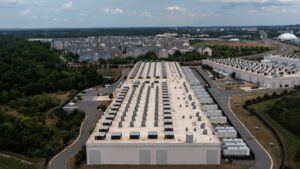Critical minerals are key to the federal government’s plan to drive jobs growth

Creating jobs and supporting the economy are the goals behind the Government's critical resources roadmap. Pic: Getty Images
Critical minerals and resources are the focus of the Australian government’s Resources Technology and Critical Minerals Processing road map, one of six key areas of focus under its broader Modern Manufacturing Strategy to create jobs and drive the economy.
The 10-year roadmap seeks to leverage Australia’s world-leading critical mineral and resources sector to create more jobs and economic opportunities for manufacturing businesses.
It aims to achieve this by turning Australia into a global centre for commercialising and manufacturing cutting-edge technology products and services for the global resources sector that will in turn benefit a range of other activities.
Additionally, it seeks to establish a strategic critical minerals processing industry that will capture additional downstream value from the country’s resource endowment while underpinning a range of advanced manufacturing opportunities.
Prime Minister Scott Morrison said this week’s numbers showing gross domestic product (GDP) growing by 3.1 per cent in the fourth quarter of 2020 demonstrated that Australia’s economy was bouncing back and that manufacturing businesses and jobs will be central to the National Economic Recovery Plan.
“Our Modern Manufacturing Initiative will help position Australia as not just a global leader in the resources sector but also in the manufacturing of the technology used, as well as turning the raw materials into value-added products,” he added.
“Today’s funding will help unlock investment from industry to help build manufacturing capability and competitiveness in Australia’s resources sector while taking advantage of a significant global growth sector.
“This investment and this Roadmap will support jobs across Australia, particularly in our resource rich regions like the Hunter, Western Australia and Central Queensland.”
Minister for Industry, Science and Technology Karen Andrews said the roadmap outlined opportunities such as turning critical minerals into batteries and solar cells along with technologies and equipment that made mining more efficient and safe.
“This funding will back businesses to pursue those opportunities and turn innovative ideas into high-value products so we can build on Australia’s competitive advantage and secure greater investment and market share,” she added.
“Developing our critical minerals processing capability will ensure Australian companies can move down the value chain, getting greater value out of the products they produce,” Minister for Resources, Water and Northern Australia Keith Pitt added.
“Our focus on resource technology will also support the development of new ideas to improve mine productivity, process efficiency and safety. As the sector’s productivity grows so does the Australian economy, benefiting all Australians.”
Roadmap goals
The roadmap calls for a number of objectives to be met the two-year, five-year and 10-year milestones with the first calling for improved capability to bring products to market through improved market development activities and investment made in critical enablers.
The first two years also calls for Australia to significantly improve resources technology and critical mineral processing manufacturing capability by increasing commercialisation, utilising critical enablers and engaging in new market opportunities.
At the five-year mark, it calls for increased collaboration with relevant sectors and international supply chains along with increased exports and the growth of private sector investment.
The final milestone calls for Australia to be seen as a regional hub for resources technology and critical minerals processing. This will include significant R&D advancements, retention in intellectual capital for SMEs and significant volume and value of exports.
Opportunities
According to the roadmap, the global demand for companies to boost productivity and environmental performance means that there are opportunities for Australian resources technology manufacturers to build scale and competitiveness
Globally, mining equipment is expected to generate revenue of US$165.8bn ($213bn) by 2027 with Asia-Pacific becoming the largest market.
It highlighted novel, cutting-edge technologies such as advanced data analytics and mapping software that include energy-saving technologies for extracting and processing ores such as:
- ore body mapping technologies;
- new geophysical tools and drilling technologies;
- automated trucks and robotic equipment; and
- grinding and processing technologies.
Adopting these technologies offers enormous cost-saving opportunities for the resource sector with autonomous haulage technology being responsible for a 20 per cent improvement in productivity.
Australia’s high environmental standards have also built a strong capability in the technology sector that could help position the country as a global maker and supplier of technology products that improve the environmental performance of resource development activities.
Technologies that improve productivity in difficult environments are also highly sought after thanks to the worldwide depletion of near-surface high-quality mineral resources and the move to extract ore bodies of increasing complexity and lower grade.
Reactions
The Climate Council welcomed the government’s plan to boost processing of critical minerals needed for batteries, solar panels and wind turbines due to its potential for strengthening the economy and creating jobs whilst tackling climate change.
“Processing minerals domestically could give Australian manufacturers a major competitive advantage in manufacturing renewable energy technologies, batteries, and electric vehicle parts,” Climate Council spokesperson and economist Nicki Hutley noted.
“It could also drive much-needed jobs transition in mining regions like the Hunter Valley in NSW, central Queensland and Western Australia.”
“Ultimately, this roadmap is a promising step towards a self-reliant minerals manufacturing sector, the development of technologies that tackle climate change, and a prime position in the global minerals market.”
However, she was critical of the government’s support for a gas-led recovery instead of a plan to power Australia with clean, affordable renewable energy.
Oil and gas lobby APPEA said the roadmap recognises and builds on Australia’s world-class expertise and competitive advantage in the resources and energy sectors.
“Australia’s oil and gas industry is already advancing and commercialising technologies such as carbon capture and storage and hydrogen that can accelerate the reduction of greenhouse gas emissions both in Australia and overseas,” APPEA chief executive Andrew McConville highlighted.
He added that the funding available under the Modern Manufacturing Initiative will help Australian manufacturers attract investment to undertake value-adding and commercialise their technology innovations.
“Based on the capability and competitiveness of our resources and energy sectors, resources technology is a manufacturing area that has untapped potential – particularly in emissions reduction technologies – and in which Australia is well positioned to become a global leader.”
Related Topics

UNLOCK INSIGHTS
Discover the untold stories of emerging ASX stocks.
Daily news and expert analysis, it's free to subscribe.
By proceeding, you confirm you understand that we handle personal information in accordance with our Privacy Policy.








